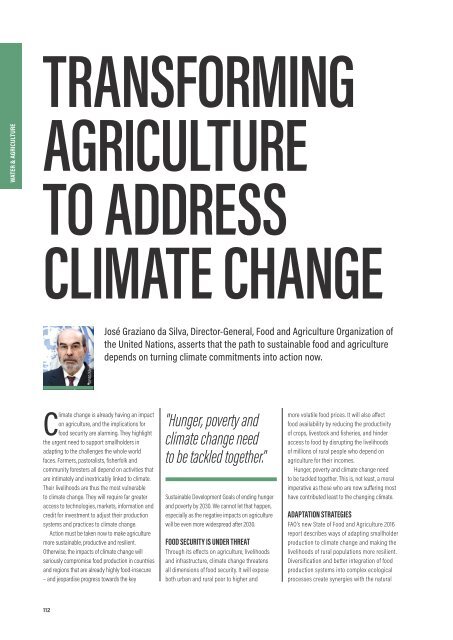Climate Action 2016-2017
You also want an ePaper? Increase the reach of your titles
YUMPU automatically turns print PDFs into web optimized ePapers that Google loves.
TRANSFORMING<br />
WATER & AGRICULTURE<br />
AGRICULTURE<br />
TO ADDRESS<br />
CLIMATE CHANGE<br />
©FAO/Alessandra Benedetti<br />
José Graziano da Silva, Director-General, Food and Agriculture Organization of<br />
the United Nations, asserts that the path to sustainable food and agriculture<br />
depends on turning climate commitments into action now.<br />
<strong>Climate</strong> change is already having an impact<br />
on agriculture, and the implications for<br />
food security are alarming. They highlight<br />
the urgent need to support smallholders in<br />
adapting to the challenges the whole world<br />
faces. Farmers, pastoralists, fisherfolk and<br />
community foresters all depend on activities that<br />
are intimately and inextricably linked to climate.<br />
Their livelihoods are thus the most vulnerable<br />
to climate change. They will require far greater<br />
access to technologies, markets, information and<br />
credit for investment to adjust their production<br />
systems and practices to climate change.<br />
<strong>Action</strong> must be taken now to make agriculture<br />
more sustainable, productive and resilient.<br />
Otherwise, the impacts of climate change will<br />
seriously compromise food production in countries<br />
and regions that are already highly food-insecure<br />
– and jeopardise progress towards the key<br />
"Hunger, poverty and<br />
climate change need<br />
to be tackled together."<br />
Sustainable Development Goals of ending hunger<br />
and poverty by 2030. We cannot let that happen,<br />
especially as the negative impacts on agriculture<br />
will be even more widespread after 2030.<br />
FOOD SECURITY IS UNDER THREAT<br />
Through its effects on agriculture, livelihoods<br />
and infrastructure, climate change threatens<br />
all dimensions of food security. It will expose<br />
both urban and rural poor to higher and<br />
more volatile food prices. It will also affect<br />
food availability by reducing the productivity<br />
of crops, livestock and fisheries, and hinder<br />
access to food by disrupting the livelihoods<br />
of millions of rural people who depend on<br />
agriculture for their incomes.<br />
Hunger, poverty and climate change need<br />
to be tackled together. This is, not least, a moral<br />
imperative as those who are now suffering most<br />
have contributed least to the changing climate.<br />
ADAPTATION STRATEGIES<br />
FAO’s new State of Food and Agriculture <strong>2016</strong><br />
report describes ways of adapting smallholder<br />
production to climate change and making the<br />
livelihoods of rural populations more resilient.<br />
Diversification and better integration of food<br />
production systems into complex ecological<br />
processes create synergies with the natural<br />
112












